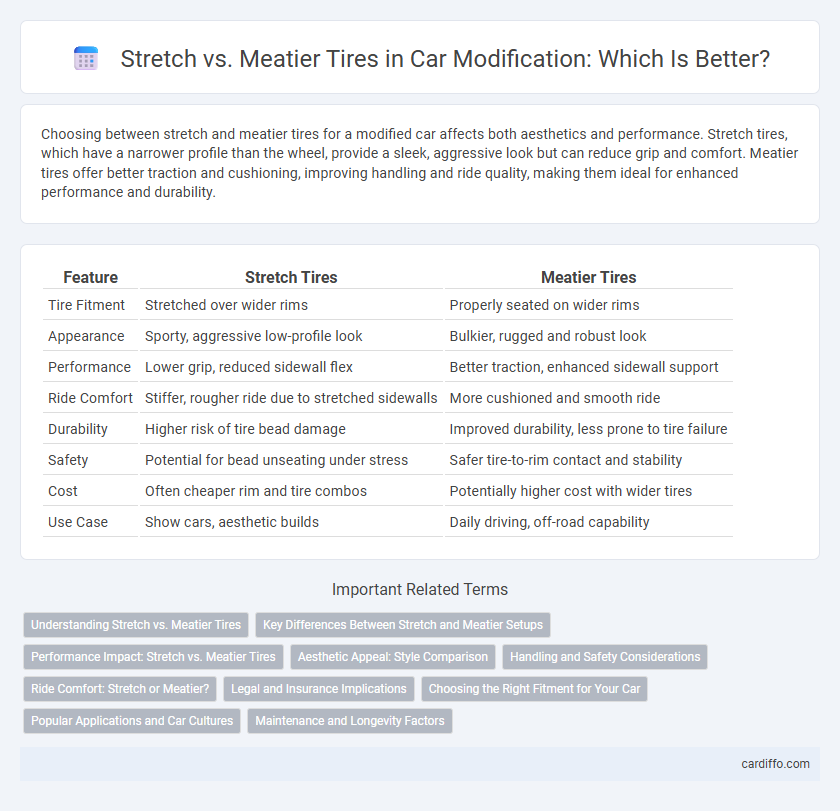Choosing between stretch and meatier tires for a modified car affects both aesthetics and performance. Stretch tires, which have a narrower profile than the wheel, provide a sleek, aggressive look but can reduce grip and comfort. Meatier tires offer better traction and cushioning, improving handling and ride quality, making them ideal for enhanced performance and durability.
Table of Comparison
| Feature | Stretch Tires | Meatier Tires |
|---|---|---|
| Tire Fitment | Stretched over wider rims | Properly seated on wider rims |
| Appearance | Sporty, aggressive low-profile look | Bulkier, rugged and robust look |
| Performance | Lower grip, reduced sidewall flex | Better traction, enhanced sidewall support |
| Ride Comfort | Stiffer, rougher ride due to stretched sidewalls | More cushioned and smooth ride |
| Durability | Higher risk of tire bead damage | Improved durability, less prone to tire failure |
| Safety | Potential for bead unseating under stress | Safer tire-to-rim contact and stability |
| Cost | Often cheaper rim and tire combos | Potentially higher cost with wider tires |
| Use Case | Show cars, aesthetic builds | Daily driving, off-road capability |
Understanding Stretch vs. Meatier Tires
Stretch tires feature narrower tread widths than their wheels, creating a distinctive look favored in the modification scene for aesthetics and improved cornering response. Meatier tires provide increased rubber contact with the road, enhancing traction, stability, and handling performance, especially in aggressive driving conditions. Selecting between stretch and meatier tires depends on balancing visual style preferences with functional performance and safety requirements.
Key Differences Between Stretch and Meatier Setups
Stretch tires feature a narrower width mounted on a wider rim, enhancing visual appeal and fitment clearance, whereas meatier tires have wider profiles providing increased traction and stability. Stretch setups prioritize aesthetics and handling precision, commonly used in show car culture, while meatier setups focus on performance grip and durability, favored in off-road and high-performance driving. Tire stretch impacts sidewall flex and ride quality, contrasting with the robust sidewalls and consistent contact patches seen in meatier tire configurations.
Performance Impact: Stretch vs. Meatier Tires
Stretch tires offer improved handling response due to increased sidewall tension, enhancing cornering precision on tight turns. Meatier tires provide superior grip and stability by maximizing the contact patch, which benefits acceleration and braking performance. The choice between stretch and meatier tires directly influences traction dynamics and vehicle control during high-performance driving.
Aesthetic Appeal: Style Comparison
Stretch tires feature a tight fit on wider rims, creating a sleek, aggressive look favored in stance and show car cultures. Meatier tires provide a bulkier, robust appearance that enhances the visual presence and rugged style of off-road and performance vehicles. The choice between stretch and meatier tires significantly impacts a vehicle's overall aesthetic, balancing sleekness versus muscularity in design expression.
Handling and Safety Considerations
Stretch tires, characterized by narrower tire widths on wider rims, can reduce sidewall flexibility, leading to compromised handling and increased risk of tire bead unseating during aggressive cornering. Meatier tires, with appropriately matched widths, enhance grip and stability by maximizing contact patch and sidewall support, directly improving vehicle handling and safety under dynamic driving conditions. Ensuring the correct tire-to-rim fit is vital to maintain structural integrity and optimal traction, minimizing the dangers of sudden tire failure.
Ride Comfort: Stretch or Meatier?
Stretch tires, characterized by a narrower tire mounted on a wider rim, often compromise ride comfort due to reduced sidewall flex and increased road feedback, leading to a harsher driving experience. Meatier tires with wider profiles and taller sidewalls provide enhanced cushioning and better absorption of road imperfections, resulting in superior ride comfort. The choice between stretch and meatier tires directly impacts suspension performance, with meatier tires promoting smoother rides on uneven surfaces.
Legal and Insurance Implications
Choosing between stretch and meatier tires can significantly impact legal compliance and insurance coverage, as improperly fitted tires may violate vehicle safety regulations and lead to fines or failed inspections. Insurance companies often scrutinize modifications like tire stretches, potentially denying claims or increasing premiums due to increased risk of accidents and damage. Ensuring tire modifications meet local road safety standards helps maintain valid insurance policies and avoids legal complications.
Choosing the Right Fitment for Your Car
Selecting between stretch and meatier tires significantly impacts your car's performance and aesthetics. Meatier tires offer enhanced grip and stability, ideal for improved traction and off-road capabilities, while stretch tires provide a sleek, aggressive look but may compromise handling and ride comfort. Prioritize tire width and aspect ratio based on your vehicle's suspension setup and intended driving conditions to ensure optimal fitment and safety.
Popular Applications and Car Cultures
Stretch tires are popular in JDM and Euro car cultures for their aggressive stance and wheel fitment aesthetics, often seen in show cars and stance builds. Meatier tires dominate in off-road, muscle, and American truck scenes, providing superior grip, traction, and durability necessary for performance and rugged terrain. Enthusiasts choose tire types based on visual impact and functional requirements specific to their automotive community.
Maintenance and Longevity Factors
Stretch tires, characterized by a narrower tire mounted on a wider rim, often experience uneven wear and increased sidewall stress, leading to more frequent maintenance and shorter lifespan compared to meatier tires. Meatier tires provide better load distribution, enhanced durability, and improved tread life, reducing the frequency of tire replacement and maintenance costs. Proper tire pressure and alignment are crucial for both types to maximize longevity and maintain optimal performance.
stretch vs meatier tires Infographic

 cardiffo.com
cardiffo.com